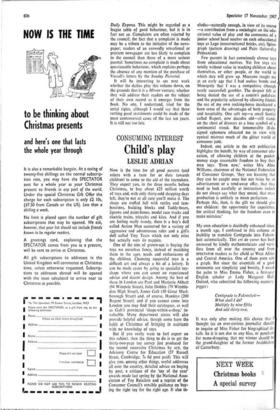Child's play
CONSUMING INTEREST LESLIE ADRIAN
Now is the time for all good parents (and others with a taste for or duty towards children) to come to the aid of the toymakers. They expect you, in the three months before Christmas, to buy about £25 million worth of toys and, with only thirty-odd shopping days left, they're not at all sure you'll make it. The shops are stuffed full with rattles and tam- bourines, building blocks and Teddy-bears, jigsaws and paint-boxes, model race tracks and electric trains, tricycles and kites. And if you are feeling really trendy, there is a boy's doll called Action Man accoutred for a variety of aggressive and adventurous roles and a girl's doll called Tiny Tears which not only cries but actually wets its nappies. Now is the time for all good parents (and others with a taste for or duty towards children) to come to the aid of the toymakers. They expect you, in the three months before Christmas, to buy about £25 million worth of toys and, with only thirty-odd shopping days left, they're not at all sure you'll make it. The shops are stuffed full with rattles and tam- bourines, building blocks and Teddy-bears, jigsaws and paint-boxes, model race tracks and electric trains, tricycles and kites. And if you are feeling really trendy, there is a boy's doll called Action Man accoutred for a variety of aggressive and adventurous roles and a girl's doll called Tiny Tears which not only cries but actually wets its nappies.
One of the sins of grown-ups is buying the toys we ourselves fancy, instead of matching them to the ages, needs and enthusiasms of the children. Choosing successful toys is a difficult art and always a bit of a lottery. It can be made easier by going to specialist toy- shops where you can count on experienced advice and decent design. Among the best of these in London are Paul and Marjorie Abbatt (94 Wimpole Street), John Dobbie (79 Wimble- don High Street), James Galt (30 Great Marl- borough Street) and, of course, Hamleys (200 Regent Street); and if you cannot come into London you may find their catalogues, as well as Gait's provincial 'shops-within-a-shop,' in- valuable. Many department stores will also provide helpful advice, though some have the habit at Christmas of bringing in assistants with no knowledge of toys.
But if you really want to feel expert on this subject, then the thing to do is to get the thirty-two-page toy survey just produced for the second successive Christmas by ACE, the Advisory Centre for Education (57 Russell Street, Cambridge; 7s 6d post paid). This will give you, among other things, useful addresses all over the country, detailed advice on buying by post, a critique of the 'toy of the year' awards made last spring by the National Asso- ciation of Toy Retailers and a reprint of the Consumer Council's sensible guidance on buy- ing the right toy for the right age. It also in- cludes—naturally enough, in view of its source —a contribution from a sociologist on the edu-
cational value of play and the comments of a junior school head teacher on such educational toys as Lego (constructional bricks, etc), Spiro. graph (pattern drawing) and Pairs (latter-day Pelmanism).
Few parents in fact consciously choose toys from educational motives. Yet few toys are totally without value in teaching children about themselves, or other people, or the world in which they will grow up. Meccano taught me at an early age that I had useless hands and Monopoly that I was a compulsive (though rarely successful) gambler. The despair felt at being denied the use of a cottsin's pedal-car and the popularity achieved by allowing friends the use of my own rocking-horse inculcated a keen sense of the advantages of both property and hospitality. One soft toy—a small Scottie called Rupert, now decades old—still stands on the chest of drawers as a lone symbol of a sentimental streak. But innumerable ill-de- signed ephemera educated me to view with cynical mistrust much of the glitter world of consumer junk.
Indeed, one article in the ACE publication highlights the benefit, by way of consumer edu- cation, of allowing children at the pocket- money stage reasonable freedom to buy their own toys. 'Even now,' writes Mrs Alma Williams, chairman of the National Federation of Consumer Groups, 'they are learning that they can be caught once but not twice by an advertisement or a send-away offer, that they need to look carefully at instructions (which do not always say what they mean), that mass production is unlikely to mean perfection. . Perhaps this, then, is the gift we should give our children: the opportunity for experience, for critical thinking, for the freedom even to make mistakes.'
My own education is decidedly enhanced since, a month ago, I confessed in this column an inability to translate Centigrade into Fahren- heit automatically. This cri de coeur has been answered by kindly mathematicians and versi- fiers from all over the country and from SPECTATOR readers as far afield as West Africa and Central America. One of them even sent a graph. But since the essentials of a good mnemonic are simplicity and brevity, I award the palm to Miss Emma Fisher, a first-year English scholar at Lady Margaret Hall, Oxford, who submitted the following memory- jogger: Centigrade to Fahrenheit—
What shall I do?
Multiply by nine fifths And add thirty-two.
It was only after making this choice that thought (as an ever-curious journalist should) to inquire of Miss Fisher for biographical de- tails. So it is not due to any bias, or penchant for name-dropping, that my winner should be the grand-daughter of the former Archbishop of Canterbury.


































 Previous page
Previous page